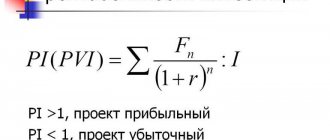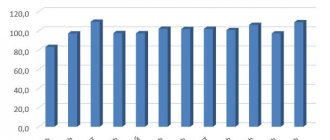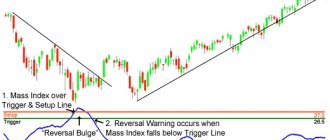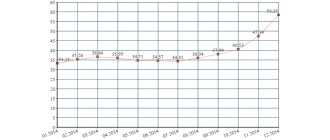What is the consumer confidence index?
Consumer confidence index (CCI) is an economic indicator based on consumer surveys, showing the general state of the economy and the expectations of the population: how confident people are in the future, in the stability of their income, and whether they are ready to spend on purchases. It is believed that the better the economy develops, the higher the consumer confidence index. Conversely, the worse things get, the more people tend to save and spend less.
An example of calculating and using the NPS loyalty index
As an example, let's look at a study of a company producing dry building mixtures. The survey was conducted among corporate clients. The results of a survey were obtained among 3 large developers, 28 organizations providing subcontracting services, and 35 stores.
When conducting the study, factors such as client status (large, medium or small business), territoriality and volume of supplies were not taken into account. As a result, three groups of respondents were identified:
- 25 promoters;
- 36 neutrals;
- 5 critics.
Let's calculate the NPS customer loyalty index:
NPS=(25-5)/66*100%=30%.
Not a bad figure, but not very high, given the little competition in this market segment.
What conclusions should be drawn? The manufacturer of dry mixes decided to focus on neutrals. Work was carried out with them:
- system of discounts for regular customers;
- gifts for repeat contact with the company;
- monthly newsletter with great offers.
Promoters were given the status of VIP clients, which provided a flexible pricing system, quarterly bonuses, and holiday gifts. Each such buyer is assigned a personal manager who maintains contact with the client.
Work was carried out with each of the critics. All claims were considered individually, and the company tried to compensate for the client’s losses. For example, a certain amount of goods in excess of the ordered amount was due for a delay in delivery.
As a result, a year later the following results were obtained (taking into account the expansion of the market coverage area):
- 42 promoters;
- 45 neutrals;
- 3 critics.
And the loyalty index was:
NPS=(42-3)/90*100%=43%.
The number of clients increased by 36%:
(90-66)/66*100%=36%.
The NPS index increased by 43%:
(43-30)/30*100%=43%.
As you can see, the work to increase loyalty was not done in vain.
Why is the CCI index needed?
Changes in the consumer confidence index are a good signal for commodity producers. Based on it, plans are made to increase or reduce production. In addition, the index helps investors make decisions regarding the selection of investment instruments. For example, an increase in the index can be regarded as a signal to purchase shares of a certain number of companies.
Traditionally, the consumer confidence index is used to forecast trends in employment and the general state of the economy, and is considered a leading indicator of the business cycle.
Advantages and disadvantages of the NPS index
The advantages of the loyalty index include the following:
- simplicity and convenience. The indicator can be calculated and analyzed using a calculator or simple programs (for example, Excel);
- low research costs;
- suitable for all types of companies whose goal is to make a profit;
- saving time for the seller and the client. Users prefer short surveys, and companies value quick results.
Flaws:
The main disadvantage of NPS research is the error, which arises for various reasons:
- random sampling;
- the specifics of the business and the audience being surveyed (opinions of consumers who differ in region of residence, income, age and other criteria may differ significantly);
- short-termism. Do not forget that the survey results are relevant “here and now”. The slightest changes (price, technology, composition of the support service, etc.) can instantly change the level of consumer loyalty. In addition, opinions are not always objective. Often the buyer leaves a good review for no reason, because it costs him nothing and he has nothing against the employee who conducted the survey. Conversely, a bad opinion is sometimes due to mood. Therefore, NPS should not be used for the long term.
How is consumer confidence calculated in the US?
The Conference Board calculates a consumer confidence index based on survey data from about 5 thousand US households. The data reflects consumer opinion on the dynamics of the labor market, the business climate and the state of the economy. The index is a leading indicator of consumer spending and the economic situation in general. The growth of The Conference Board Consumer Confidence Index indicates an increase in consumer confidence.
Particular attention of market participants is attracted by sharp deviations in the consumer confidence index. The landmark level for the Consumer Confidence Index is 93 – the average value for 20 years. The index going below this figure could increase risk appetite and trigger sales of dollars to buy shares.
Finding the index at higher levels can be regarded as an additional signal for the Fed to tighten monetary policy and strengthen the position of the US dollar.
- Publication date : every last Tuesday of the month at 18:00 Moscow time;
- Source : US Conference Board
- Website : https://www.conference-board.org/data/consumerconfidence.cfm
- Significance : high.
The growth of the CCI index leads to a strengthening of the US dollar, an increase in stock indices, and has an impact on world stock exchanges.
Nielsen: Consumer Confidence Index Has Significant Fall in 15 Years
In the second quarter of 2021, consumer confidence worldwide experienced its worst decline in 15 years. This data is provided by Nielsen in its report, which was received by Sostav.
The company compared the results of the second quarter of this year with the fourth quarter of 2021 - these periods reflect the mood before the COVID-19 pandemic and after the first wave of the crisis. In Russia, the consumer confidence index dropped to 62 points—by 6 percentage points. by the fourth quarter of last year. This is an anti-record; the same result was recorded in the first quarter of 2021, analysts emphasize.
Nielsen
Global index values decreased more significantly. In the world - by 14 percentage points, to 92 points. In Europe - by 12 percentage points, to 74 points, Nielsen added.
The index consists of three indicators: consumer assessment of prospects in the labor market, level of financial well-being and willingness to spend money. In Russia, values for all these positions have decreased. The number of citizens of the country who expect “good” or “excellent” financial prospects in the next six months has decreased by 23%. The number who think now is a good time to spend money has dropped to 17%. Only 15% are confident in the prospects in the labor market, experts say.
The share of Russians who have free money (remaining after spending on basic needs) reached 74% in the second quarter (versus 78% in the fourth quarter of 2021). However, the number of items on which these funds are spent has decreased. 35% of consumers now spend on clothing, 20% on entertainment outside the home, and 29% on vacations. 26% of respondents saved money, and 29% paid off debts.
In the second quarter, Russians seriously saved on buying clothes (61%), entertainment outside the home (51%) and groceries (45%). They also saved money on vacations (42%), alcohol and communication services (19% and 15%, respectively).
Nielsen
In the second quarter, Russians were most worried about the state of the economy—39% of respondents said this, which is an increase of 20 percentage points. exceeds the figure for the last quarter of 2021. Citizens were also concerned about their health (30%), rising food prices (29%) and job security (27%).
Nielsen
Marina Volkova, director of analytics and consulting Nielsen Russia:
The negative impact of the COVID-19 pandemic has been felt by most countries around the world, so the current value of the consumer confidence index does not come as a surprise to anyone. FMCG manufacturers and retailers suffered less than others in the current situation, which, however, were forced to make large-scale investments in the development of logistics capacities and curbing price increases. It is likely that they will reconsider their strategies to prepare for possible difficulties in the future, however, it is too early to draw long-term conclusions.
How is the CCI index calculated in Russia?
Regular surveys of consumer behavior in Russia have been conducted by Rosstat since 1998 quarterly (in February, May, August and November) covering 5.0 thousand people aged 16 years and older living in private households in all constituent entities of the Russian Federation.
The survey questionnaire includes questions about the respondent’s subjective opinion about the general economic situation and personal financial situation, about the situation in the markets for goods (services) and savings. The respondents' answers are distributed according to the following options:
- definitely positive or definitely negative (very good, very favorable/very bad, completely unfavorable);
- rather positive or rather negative (good, rather favorable/bad, rather unfavorable);
- neutral (average, “pros” and “cons” are the same).
According to the methodology of the European Commission, the values of private indices and the general index of consumer confidence of the population are calculated.
The information obtained as a result of a survey of consumer expectations of the population can be used, along with quantitative statistical data, to analyze the behavioral model of the population in the consumer market, as well as to assess the impact of consumer activity on the state of the economy as a whole.
How to keep your NPS score high
Let’s summarize the list of actions that will help maintain customer trust.
- Bonus system. Encourage new clients, as well as those who have been working with you for a long time. Small gifts, congratulations on birthdays and other holidays, discounts for volume, promotions - all this works in favor of increasing the loyalty index.
- Live communication. People don't really like talking to robots. An automated system is convenient for you, but not for the client. You shouldn’t make your customer go through ten circles of hell to reach a live employee. An individual approach to problem solving is highly valued.
- Large companies need a department to handle complaints: returns, supply disruptions, decreased quality of services - all issues need to be resolved as quickly as possible.
Special Considerations
The Conference Board is a global independent business and research association. Founded in 1916, its mission is to provide the world's leading organizations with the practical knowledge they need to improve their operations and better serve their communities. The Council is dedicated to helping its members understand and navigate the most important issues of our time. The council also conducts research and forums that bring together business leaders. These ideas feed into his research and meeting agendas.
Comparison with other countries
In comparison with other countries occupying the first 30 lines in the ranking with the best purchasing power situation, the situation in Russia is as follows, these are the countries that top the list:
- Qatar.
- Luxembourg.
- Singapore.
- Brunei.
- Kuwait.
- Norway.
- United Arab Emirates.
- Hong Kong.
- USA.
- Switzerland.
- Saudi Arabia.
- Bahrain.
- Holland.
- Ireland.
- Australia.
- Austria.
- Sweden.
- Germany.
- Taiwan.
- Canada.
- Germany.
- Oman.
- Iceland.
- Belgium.
- France.
- Finland.
- England.
- Japan.
- South Korea.
- New Zealand.
An interesting fact is that Russia occupies 51st place in this ranking of countries, behind Kazakhstan, Poland, Bohemia, Malaysia, Greece, Estonia, Lithuania, Cyprus, Slovakia, the Czech Republic, Equatorial Guinea, Slovenia, Trinidad and Tobago.
The essence of consumer society
It is very difficult to calculate when the consumer society appeared. But there is a clear understanding that this happened with the advent of industrial production and increased competition. An important step towards a consumer society was the emergence of marketing. The fact is that the media and advertising have given the population the opportunity to see how others live, people have a desire to live better. If previously a person satisfied his basic needs for food and housing, now he wants to eat expensive products and drive an expensive car. For many people, the stimulus in life has become things that sometimes a person does not need. You are ready to take out a loan on unfavorable terms just to drive an expensive car or buy an expensive TV. We can safely say that consumer society is based on human greed and envy. Only this can explain the sometimes simply shocking actions of people, for example, in China, a boy sold a kidney to buy an iPhone. In fact, this act is not much different from taking this product on credit. Because the phone itself, for that kind of money, only serves to satisfy one’s pride and greed.
Compound
When it becomes clear what the purchasing power of the population is and what factors influence it, it is necessary to consider the structure of monetary expenses of Russian citizens, expressed as a percentage:
- Purchase of goods accounts for 58.8%.
- Mandatory payments take up 9.9% of the budget.
- It takes up to 15.4% to pay for services.
- Savings – this takes 8.8%.
- Citizens spend approximately 2% of total income on purchasing foreign currency.
- For the purchase of real estate - 3.9% of the monthly average annual income.
- The purchase of livestock and poultry in rural areas costs 0.4%.
- Payments for goods and services using bank cards abroad are 0.8%.
As you can see, the main share in the expenses of the Russian population is still the purchase of food. Moreover, due to the rather low standard of living, the column associated with study, recreation, travel, as well as payment for other services takes up no more than 15% in total. Which is significantly lower than in other developed countries.











